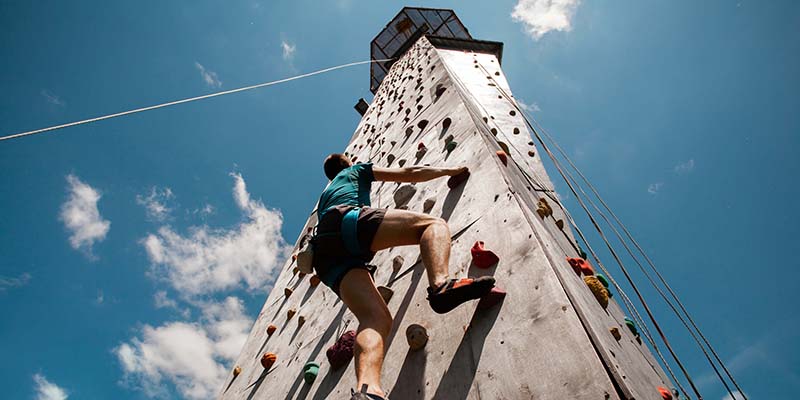
Static Climbing Rope for Big Wall Climbing: Meeting the Challenges of Vertical Adventures
Rock climbing, a sport derived from mountaineering, encompasses a multitude of disciplines based on various climbing types. Two of the most common forms, bouldering and sport climbing, fall under the broader umbrella of rock climbing. Distinguishing these categories can be boiled down to two primary factors: 1. climbing height and 2. the presence of rope protection. Let's delve into the fundamentals of bouldering and sport climbing, highlighting their key differences.
Bouldering:
・Bouldering requires minimal equipment and primarily relies on a suitable pair of climbing shoes to begin the ascent.
・Climbing walls in bouldering typically range from 3 to 4 meters in height. Since no ropes are used, crash pads are placed beneath the wall to provide a safety cushion for falls (learning proper falling techniques is crucial to prevent injuries).
・In comparison to sport climbing, bouldering routes are shorter, allowing climbers to attempt a variety of routes within a short timeframe. This demands higher levels of explosiveness and strength.
Sport Climbing:
・Sport climbing offers a variety of subtypes, with top roping being the common entry point for beginners. In top roping, anchors and ropes are pre-installed above the climber.
・Climbing walls in sport climbing gyms can reach heights of around 10 to 25 meters, making proper rope management essential.
・Mastery of equipment use is crucial in sport climbing, including climbing shoes, harnesses, carabiners, belay devices, and mastering knots like the figure-eight knot.
・Climbers rely on a knowledgeable belay partner for safety in sport climbing. It's imperative to double-check the correct usage of equipment before ascending. Some climbing gyms feature automatic belay devices, enabling solo climbing (self-checks are still essential).
・Sport climbing routes are longer, demanding sustained muscle endurance and precise pacing during the ascent.
Understanding Climbing Routes:
Entering a climbing gym, climbers are greeted by colorful holds and tape, each representing routes of varying difficulty. Recognizing a complete route is as simple as following holds of the same color. Each route has a starting hold and a finishing hold (often marked with tape). The starting hold indicates where climbers position their hands (or feet), and the finishing hold, usually at the highest point, signifies the end of the route.
Dispelling Strength Misconceptions:
While climbing may appear strength-centric, technique is equally critical. A climber's ability to apply technique and decipher routes means that even individuals with less physical strength, such as women, can navigate routes more efficiently than stronger counterparts (a sentiment shared by the author). Initial frustrations are natural, but through practice and persistence, achieving a sense of accomplishment upon completing a route becomes deeply gratifying.
Choosing Bouldering or Sport Climbing as a Novice:
Both bouldering and sport climbing are suitable for beginners. Bouldering's minimal equipment requirements and shorter walls make it an accessible starting point. Meanwhile, sport climbing, guided by professionals, is also viable for beginners. Many climbing gyms offer professional coaching and comprehensive equipment rental services. Whether attempting climbing solo or learning with friends, the joy of climbing can be savored!
Whether engaging in any outdoor activity, our initiation typically revolves around understanding equipment. Given the life-critical nature of climbing gear, it's imperative to acquaint ourselves with their safety aspects.
Sport climbing comes with more limitations and requires two participants—one climbing and one belaying. Climbers need personal gear, including a harness and climbing shoes, while belayers must master belay devices (like GriGri or ATC) to secure the climber's safety.
Bouldering, on the other hand, stands as a solo activity. With no need for belayers, only climbing shoes are essential. Miniature bouldering centers abound, requiring only courage to step inside. For newcomers to either sport or bouldering, joining a climbing gym's introductory programs is advised. These sessions provide foundational teachings, from route completion to muscle utilization and proper falling techniques, fostering familiarity with the sport.

Fortunately, some climbing facilities feature "auto belay devices," replacing human belayers with machines. These devices attach to climbers' harnesses, allowing them to climb safely. When descending, the auto belay device gently lowers climbers to the ground. While these devices prevent mid-climb rests (takes), they offer a chance for those without belay partners to experience the joy of climbing. However, the moment climbers release the device upon completing a route still necessitates unwavering psychological resilience.
This article provided an introduction to using static climbing rope for conquering the challenges of vertical big wall climbing. It discussed considerations for vertical climbing and the essential rope equipment needed for a safe and successful vertical adventure.

